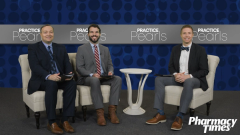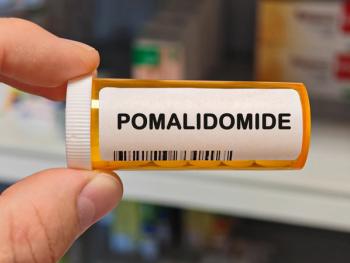
Differentiating Treatment Strategies for Indolent Versus Aggressive Relapse MM
Medical experts discuss treatment options for indolent and aggressive relapse multiple myeloma.
Ryan Haumschild, PharmD, MS, MBA:As we look at treating indolent relapsed multiple myeloma, how is it treated compared with aggressive relapse? Are there similarities in terms of the treatment approach? What specifically is different for indolent compared with more aggressive relapse?
Larry Anderson, MD, PhD, FACP: We’re blessed to have many treatment options for relapsed myeloma. We have a lot of options. In general, if patients have a more indolent relapse, we’ll use combinations of oral and subcutaneous vs if they’re more aggressive, we’ll possibly use a more intravenous route, which we can get in quicker and get a rapid response. Things that also affect the decisions are, where does the patient live? What kind of caregiver support do they have? Do they have a driver? Are they bedbound? A lot of these other factors come into play when deciding on a treatment for these patients. Often I’ll go into the room expecting to recommend 1 regimen, but after speaking with the patient and their family, I’ll have a completely different plan when I come out of the room.
Ryan Haumschild, PharmD, MS, MBA: I love the idea of shared decision-making. It’s so important. Considering social determinants of health, what does transportation vulnerability look like? [A patient might live] 6 miles away in an urban environment but have a lot of difficulty coming in, or 300 miles away and on a farm. Those considerations are so important. Dr Anderson, how does the length of remission change for each subsequent relapse? How does this influence your choice of therapy? [We need to think about] fit status and patient characteristics and if it’s an older population. What are your thoughts?
Larry Anderson, MD, PhD, FACP: Patients with myeloma will have many relapses over the course of their disease. Historically, remission intervals become shorter with each subsequent line of therapy. We tend to use some of our best options earlier to get that longest remission before they have multiple relapses. Although with some of the newer agents, like CAR [chimeric antigen receptors] T cells and bispecific antibodies for very late relapses, we’re seeing the opposite. We’re seeing longer remissions in later-line therapies, which is paradoxical to what we’re used to seeing with subsequent lines of therapy.
Ryan Haumschild, PharmD, MS, MBA: How does treatment response to prior lines of therapy impact treatment selection moving forward? If you’re doing a proteasome inhibitor or a triplet therapy and seeing relapse earlier, does that change the way you’re treating the patient moving forward? Talk us through that.
Larry Anderson, MD, PhD, FACP: There are a few things to think about. Obviously, if a patient has failed or relapsed on a therapy before, we’ll avoid that 1. It depends on how aggressive or indolent the relapse is. If we want to switch agents within a class, that can be very helpful and still minimize toxicity and the cumbersome nature of the therapy. But if patients are having a more aggressive relapse, we’ll probably switch classes on that patient completely and use combination therapies—at least 3 drugs for most of these patients.
Ryan Haumschild, PharmD, MS, MBA: That’s a great overview of the treatment approaches. It’s individually specific based on how the patient is responding. Mr Hinojosa, we know there’s a high-cost burden associated with these diseases, specifically multiple myeloma. When we look at the literature around pharmacoeconomic impacts, some of the highest spend per plan or hospital is dedicated to patients with multiple myeloma. We don’t want to not treat these patients. There have been a lot of innovative therapies. I’d love to hear your thoughts on how the economic burden changes as patients start to progress toward that relapsed or relapse refractory stage of their disease. What do you see the impact being as we move forward with additional treatments being approved?
Gabe Hinojosa, PharmD, BCOP: That’s a very important factor to consider for the patient and the health care system as a whole: what is the economic burden, and how will that impact the overall care? As the patient progresses through multiple relapses, the economic burden for the patient and the health care system grows exponentially. You start by looking at the costs of a regimen of primarily oral agents with 1 or 2 oral medications and a subcutaneous injection, which has a relatively low cost. As you move on, you start comparing the cost of that vs a high-dollar [treatment], like a bispecific antibody. Even the cost of an autologous stem cell transplant is going up. The cost of CAR T-cell therapy is exponentially higher than the cost of a 2-drug oral regimen. It’s always important to consider. Beyond the superficial cost of the initial therapy itself is also the cost of the additional supportive care if patients are at a higher risk for infections. If patients have multiple relapses, we may see higher incidence of bone fractures and things that require additional treatments. As we get into newer therapies, we have the management of some of these complex toxicities. We see an economic impact on the health care system from managing complex toxicities like CRS [cytokine release syndrome] and ICANS [immune effector cell-associated neurotoxicity syndrome] with immunotherapy.
Ryan Haumschild, PharmD, MS, MBA: I like your response because you touched on the cost of not only therapies but also health care resource utilization, including some adverse effects we’re seeing. That’s so relevant. It’s an exciting time in multiple myeloma, so I have questions for you both. I’ll start with Dr Anderson. We’ve had a lot of progress within multiple myeloma, with a lot more therapies approved—oral treatments, subcutaneous, bispecifics, cellular therapies. What unmet needs still exist within multiple myeloma? Specifically, what unmet needs exist for patients who experience indolent relapse?
Larry Anderson, MD, PhD, FACP: Two of the biggest unmet needs are, No. 1 we still can’t cure myeloma. There are rare exceptions—a patient here and there may be in long-term remission for 15 to 20 years, and we can’t explain why—but almost everyone will relapse and go through multiple lines of therapy over the course of their disease. We’re hopeful that combining some newer immunotherapies and moving them earlier might impact that. Not having a cure is 1 of the biggest unmet needs. Not having a defined duration of therapy is another unmet need. We have a lot of data that most of our patients tend to do better by staying on therapy indefinitely. But we’re starting to get some data that at least a subgroup of patients may not need to stay on that forever and could come off after a couple of years or at least minimize the treatment after a couple of years. We need more data around the defined duration of these therapies, especially when we’re combining multiple agents that are quite expensive and toxic. We’re trying to pair that down to what the patient really needs.
Ryan Haumschild, PharmD, MS, MBA: Those are great points. I’m also excited about the potential of MRD [minimal residual disease] and how that can take place. [We could] even keep a patient off maintenance therapy for a little while if they’re truly meeting the necessary requirements. We need more data before we can get there. But I agree. That’s an exciting option in the future.
Mr Hinojosa, any additional information you want to share on unmet needs in multiple myeloma, especially those with indolent relapse?
Gabe Hinojosa, PharmD, BCOP: In recent years, there were large unmet needs for patients with multiple lines of relapse. Many of these patients will eventually experience or be exposed to most myeloma therapies. [We need to] be able to identify new targets like BCMA and GPRC5D, which have already met some of those unmet needs of recent patients who had run out of options. We’re looking for more data on the best way to sequence these therapies and when to offer which patient what drug. That applies to those with indolent relapse as well.
Transcript edited for clarity.
Newsletter
Stay informed on drug updates, treatment guidelines, and pharmacy practice trends—subscribe to Pharmacy Times for weekly clinical insights.












































































































































































































